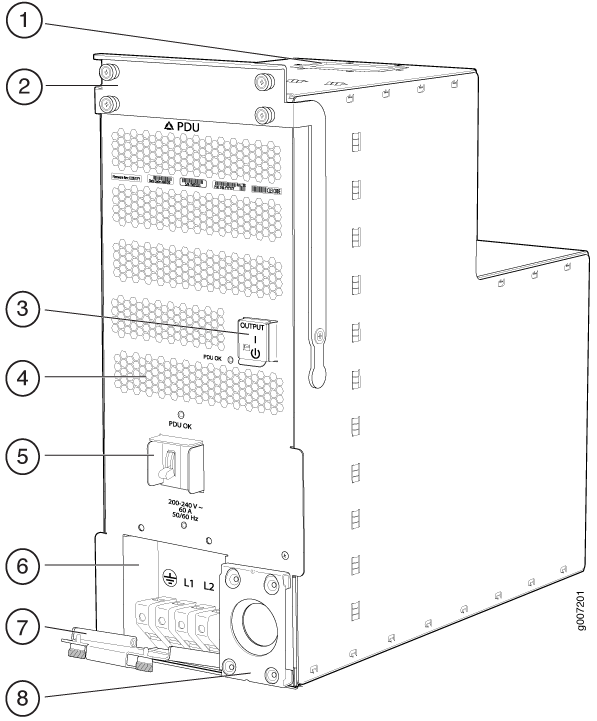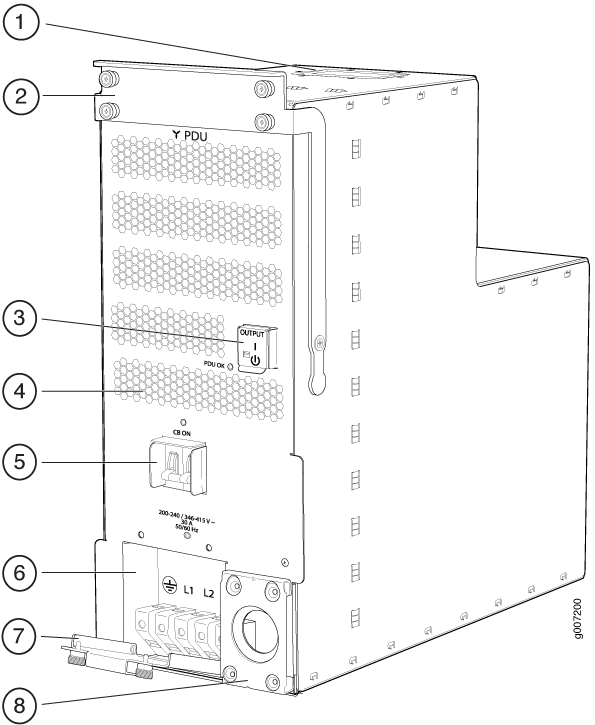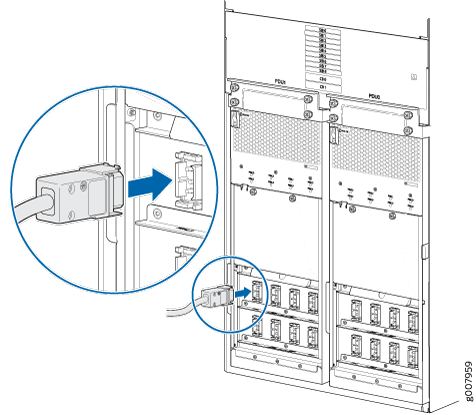ON THIS PAGE
Maintaining the PTX5000 AC Power System
Maintaining the PTX5000 AC Power System
Purpose
For optimum performance, verify the condition of the power distribution units (PDUs), power supply modules (PSMs), AC power cords, and grounding cables.
Action
On a regular basis:
Periodically inspect the site to ensure that the grounding and AC power cords connected to the PTX5000 are securely in place and that no moisture is accumulating near the PTX5000. To review grounding and site wiring requirements for the PTX5000, see PTX5000 Chassis Grounding Cable and Lug Specifications and Site Electrical Wiring Guidelines.
Check the status of the PDUs by issuing the
show chassis environment pducommand.Make sure that the AC power cords are arranged so that they do not obstruct access to other router components.
Routinely check the status LEDs on the PDU and PSM faceplates and the craft interface to verify that the power system is functioning normally.
For more information about the PDU and PSM LEDs, see PTX5000 AC Power Distribution Unit LEDs and PTX5000 AC Power Supply Module LEDs.
Check the red and yellow alarm LEDs and the LCD display on the craft interface. PDU and PSM failure or removal triggers an alarm that causes one or both of the LEDs to light and an error message to appear on the LCD display. You can display the associated error messages by issuing the following CLI command:
user@host> show chassis alarms
For a list of possible alarm messages, see Troubleshooting the PTX5000 Power System.
The power system requires an unobstructed airflow at both the front and rear of the chassis. Periodically check the site to ensure that both the air intake at the bottom front of the chassis and the exhaust from the PSM faceplates are unobstructed.
To check the power usage in watts for all PDUs and PSMs, issue the
show chassis powercommand .Chassis Power Input(V) Used(W) Total Power 3810 PDU 0 3810 PSM 0 Input 1 54 331 PSM 1 Input 1 54 661 PSM 2 Input 1 54 1432 PSM 3 Input 1 54 1386Issue the
show chassis power detailcommand to check the power usage in watts for hardware components such as FPCs, fan trays, Routing Engine and Control Board, and SIB, CCG, and craft interface.user@host> show chassis power detail Chassis Power Used(W) Total Power 4890 PDU 0 2447 PSM 0 1292 PSM 1 702 PSM 2 210 PSM 3 243 PDU 1 2443 PSM 0 1291 PSM 1 685 PSM 2 196 PSM 3 271 Item Used(W) Fan Tray 0 194 Fan Tray 1 482 Fan Tray 2 488 RE0/CB0 107 RE1/CB1 108 SIB/CCG/FPD 63 FPC 0 0 FPC 1 0 FPC 2 0 FPC 3 0 FPC 4 0 FPC 5 0 FPC 6 8 FPC 7 0
Replacing a PTX5000 Three-Phase Delta AC PDU
Removing a PTX5000 Three-Phase Delta AC PDU
The PTX5000 has two redundant, load-sharing PDUs. Each PDU is hot-insertable and hot-removable. The PDU weighs 51.2 lb (23.2 kg).
To remove a three-phase delta PDU:
Do not touch the power connectors on the rear of the PDU. They can contain dangerous voltages.
Do not leave a PDU slot empty for more than a short time while the PTX5000 is operational. For proper airflow, the PDU must remain in the chassis or a blank panel must be used in an empty slot.

1 — Top installation handle | 5 — Circuit breaker |
2 — Front installation handle | 6 — Metal wiring compartment |
3 — Output power switch | 7 — Metal wiring compartment door |
4 — Air exhaust ventilation | 8 — Metal retaining bracket |

Installing a PTX5000 Three-Phase Delta AC PDU
To install a three-phase delta AC PDU:

Replacing a PTX5000 Three-Phase Delta AC PDU Power Cord
- Removing a PTX5000 Three-Phase Delta AC PDU Power Cord
- Installing a PTX5000 Three-Phase Delta AC PDU Power Cord
Removing a PTX5000 Three-Phase Delta AC PDU Power Cord
To remove a three-phase delta PDU power cord:
Installing a PTX5000 Three-Phase Delta AC PDU Power Cord
To install a three-phase delta AC power cord:
Replacing a PTX5000 Three-Phase Wye AC PDU
Removing a PTX5000 Three-Phase Wye AC PDU
The PTX5000 has two redundant, load-sharing PDUs. Each PDU is hot-insertable and hot-removable. The PDU weighs 51.2 lb (23.2 kg).
To remove a three-phase wye PDU:
Do not touch the power connectors on the rear of the PDU. They can contain dangerous voltages.
Do not leave a PDU slot empty for more than a short time while the PTX5000 is operational. For proper airflow, the PDU must remain in the chassis or a blank panel must be used in an empty slot.

1 — Top installation handle | 5 — Circuit breaker |
2 — Front installation handle | 6 — Metal wiring compartment |
3 — Power OUTPUT switch | 7 — Metal wiring compartment door |
4 — Air exhaust ventilation | 8 — Metal retaining bracket |

Installing a PTX5000 Three-Phase Wye AC PDU
To install a three-phase wye AC PDU:

Replacing a PTX5000 Three-Phase Wye AC PDU Power Cord
- Removing a PTX5000 Three-Phase Wye AC PDU Power Cord
- Installing a PTX5000 Three-Phase Wye AC PDU Power Cord
Removing a PTX5000 Three-Phase Wye AC PDU Power Cord
To remove a three-phase wye PDU power cord:
Installing a PTX5000 Three-Phase Wye AC PDU Power Cord
To install a three-phase wye AC power cord:
Replacing a PTX5000 Normal-Capacity AC PSM
Removing a PTX5000 AC PSM
To remove an AC PSM:
Installing a PTX5000 AC PSM
To install an AC PSM:
- Using both hands, slide the PSM into the chassis until you feel resistance . Each AC PSM weighs approximately 10.5 lb (4.8 kg).
- Push the ejector handle toward the PSM, and tighten the captive screw on the PSM.
- Verify that the AC IN OK LED on the PSM faceplate is lit steadily, indicating that the PSM is receiving power.
- Verify that the DC IN OK LED on the PSM faceplate is lit steadily.

Replacing a PTX5000 High Capacity Delta AC PDU
Removing a PTX5000 High Capacity Delta AC PDU
The PTX5000 has two redundant, load-sharing PDUs. Each PDU is hot-insertable and hot-removable. The High Capacity Delta AC PDU weighs 63.3 lb (28.7 kg).
To remove a High Capacity Delta AC PDU:
Do not touch the power connectors on the rear of the PDU. They can contain dangerous voltages.
Do not leave a PDU slot empty for more than a short time while the PTX5000 is operational. For proper airflow, the PDU must remain in the chassis or a blank panel must be used in an empty slot.
Installing a PTX5000 High Capacity Delta AC PDU
To install a High Capacity Delta AC PDU:
Replacing a PTX5000 High Capacity Wye AC PDU
Removing a PTX5000 High Capacity Wye AC PDU
The PTX5000 has two redundant, load-sharing PDUs. Each PDU is hot-insertable and hot-removable. The High Capacity Wye AC PDU weighs 63.3 lb (28.7 kg).
To remove a High Capacity Wye AC PDU:
Do not touch the power connectors on the rear of the PDU. They can contain dangerous voltages.
Do not leave a PDU slot empty for more than a short time while the PTX5000 is operational. For proper airflow, the PDU must remain in the chassis or a blank panel must be used in an empty slot.

Installing a PTX5000 High Capacity Wye AC PDU
To install a High Capacity Wye AC PDU:
Replacing a PTX5000 High Capacity Single-Phase AC PDU
Removing a PTX5000 Single-Phase AC PDU
The PTX5000 has two redundant, load-sharing PDUs. Each PDU is hot-insertable and hot-removable. The Single-Phase AC PDU weighs 60.5 lb (27.4 kg).
To remove a Single-Phase AC PDU:
Do not touch the power connectors on the rear of the PDU. They can contain dangerous voltages.
Do not leave a PDU slot empty for more than a short time while the PTX5000 is operational. For proper airflow, the PDU must remain in the chassis or a blank panel must be used in an empty slot.

Installing a PTX5000 High Capacity Single-Phase AC PDU
To install a Single-Phase AC PDU:
Replacing a PTX5000 High Capacity AC PSM
Removing a PTX5000 High Capacity AC PSM
To remove a High Capacity AC PSM:
Installing a PTX5000 High Capacity AC PSM
The High Capacity DC PSMs are smaller in dimensions compared to the first-generation PSMs. So, you must install the PSM sleeves to install the High Capacity DC PSMs in the chassis. See Installing the High Capacity PSM Sleeves for details. Each High Capacity AC PSM weighs approximately 9.8 lb (4.5 kg).
To install a High Capacity AC PSM:

































